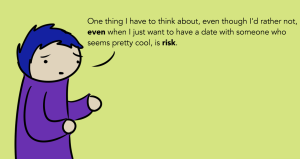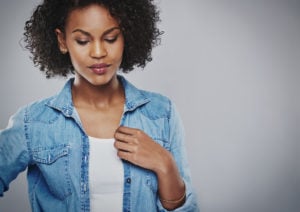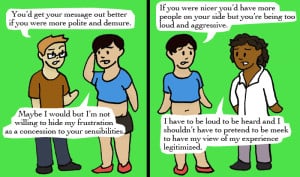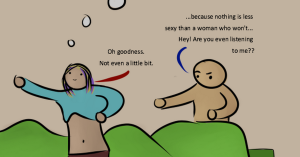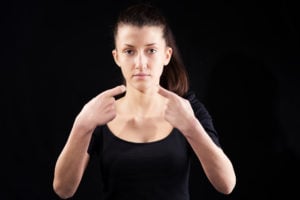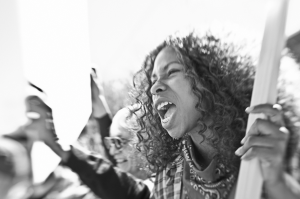
Source: xoJane
Originally published on xoJane and republished here with their permission.
A couple of years ago, I was at a rooftop party in New York with some of my cousins.
I was too young to drink and too shy to mingle, so I hung around awkwardly while they chatted with an attractive blond man who appeared to be in his late twenties.
They tag teamed as he pried them with exoticizing questions about their “home country,” flashing his white teeth in jovial approval when they played along with his racist quips. They seemed to be having a good time amusing one another, so I was shocked when pointed his glass in my direction to acknowledge me.
“And what about you?” he said. “You don’t even look Indian.”
Before I could open my mouth, one of my cousins chimed in, “Oh, she’s not. She’s half black.”
“Oh,” he said. They resumed their conversation and I resumed trying to look like I was having a good time.
This happens when I am with my cousins.
I was at a St. Patty’s party with one of them about a year ago when I heard someone whisper into her ear, “Is your cousin black?”
A few months later, I was out to dinner with their group of friends when someone asked me, “Are you guys actually related? You look like you’re from Eritrea or Ethiopia or something.”
“I’m from Pennsylvania, and we’re first cousins. Believe it or not, you don’t actually have to look alike to be related” is what I would have liked to have said. But I was tipsy and there were too many people around, so I said something along the lines of “Yeah, we get that a lot.”
My mother tried to explain to me when I was younger that I was black, and only black, because that is how the world would see me. I resented that. In my eyes, I had an African American mother and a Gujarati father, and that is how the world would see me, because that’s what I was.
I clung onto that belief way past its expiration date despite experience constantly flinging my naïveté back in my face. The rules of miscegenation were set long before I came along, and my self-determination to “be myself” was not going to change it.
Race in the US operates through hypodescent, meaning that children inherit the race of the parent who is lower in our socially constructed racial hierarchy. This is why President Obama, who is black and white, can refer to himself as a black man and never as a white man.
It is a rule that was created to protect white slave masters from having to recognize the kin they made with black bodies, solidified by long-abolished laws, and still deeply permeating society today.
But we don’t often discuss how these miscegenation and colonialism rules come into play outside of the realm of whiteness — such as when you mix black and brown, in my case.
It’s obviously much more complex than blending paint swatches on a color palette, but I can tell you from experience that I did not get the Katrina Kaif treatment. The actress’s biracial identity as half white and half Indian has arguably landed her numerous Bollywood parts because of her “desirable” light skin. Like many areas of the world reeling from colonialism, Indian culture is deeply permeated by Eurocentric beauty standards, so I won’t be featured in Bollywood anytime soon.
Of course, nothing this complex went through my middle school brain. I just knew when a substitute teacher told me “I guess we don’t use normal names like Mary or Sue anymore” when he got to my name on roll, it was one of my peers chiming in “Her name’s normal in her dad’s country!” that led him to half-heartedly apologize.
People spoke about my being South Asian with envy when I did well on a math test, and told me “It’s because you’re black” to my face when I asked for extra help in physics. (My middle school brain also failed to grasp the damaging effects that type of ignorance could have on someone racialized as South Asian daily.)
Cue a montage of my obsession and failure to disappear into Indian culture. I spent hours teaching myself Hindi, watching Bollywood movies, and reading children’s versions of the Ramayana and Mahabharata.
I tried to look nonchalant when a relative of mine wordlessly walked past me at a cousin’s wedding to coo over my cousin’s fair skin. I hid the hurt when aunties prepared less-spicy versions of food for my less-Indian palette, fraying away at my charade to shield myself in my father’s culture to escape blackness.
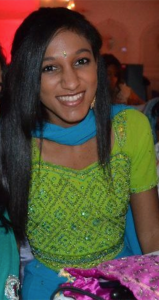
But I could still firmly straddle that area in-between.
I’m disgusted to say it, but there was a time when I secretly liked it when people stopped me in elevators or on the sidewalk to ask me where I was from because they couldn’t figure it out for themselves.
It was reaffirmation that I was transcending my racial identity into a realm of ambiguity, that I wasn’t necessarily the student held back by her blackness in physics class. My shameless survival method was to disassociate myself from being black and to wrap myself in the palatable exoticism, tangy flavors, and bright colors that my cultural oppressors loved.
Fortunately for me, I had the opportunity in college to take part in classes and discussions that expanded my consciousness and taught me to foster a deep-growing pride and confidence in my black identity. Today, there is no question — identifying as a black woman is something that I am deeply and immensely proud of.
Yet I’ve found myself harboring a bitter resentment rooted in my prior inability to disappear into Indian-ness with the same ease I can disappear into blackness.
The logical part of me knows why — the rule of hypodescent. The hierarchy keeps black, brown, red, and yellow apart so that they never unite against a common oppressor. But the petty part of me has allowed it to manifest in me ignoring that part of my identity entirely.
Now, in conversation, I refer to myself as a black woman — no hyphen, no part anything else. I have channelled my self-righteous anger at a family who was just trying to be thoughtful when they took the extra time to prepare non-spicy dishes for me, as if they were not also victims of the bitter racism and deep-seated effects of colonialism that plague people of color in this country.
I’m not someone who suffers from some tragic confusion because I’m mixed-race, but I am someone whose complicated relationship with herself has been compounded by multiple racial identities.
It has been easier for me to blame the people within my vicinity for the negative experiences weighing down my soul. It’s harder for me to look to larger enemies such as racism and oppression and think of ways to combat them, and especially while I am held down by hidden and shattered parts of myself.
But if systems like the ones that have plagued me are solidified by hierarchies and divisions, then they can only be cracked by unity and alliance. For me, that starts within myself — by molding my racial identity from broken halves into a beautiful whole.
[do_widget id=”text-101″]
Anjali Patel is a freelance writer and visual artist who creates content concerning race, gender, and anything nerdy. Her work has appeared on BuzzFeed, Medium, Black Girl Nerds, and her personal blog, Chitlins Con Curry. You can keep up with her work by following her on Twitter @anjapatel.

Search our 3000+ articles!
Read our articles about:
Our online racial justice training
Used by hundreds of universities, non-profits, and businesses.
Click to learn more





